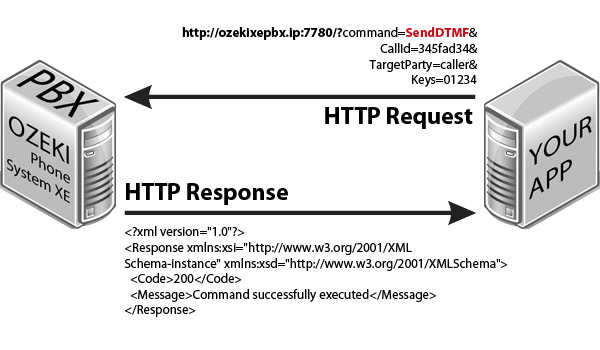SendDTMF
The SendDTMF command is used to send a DTMF message to a participant of the conversation. The target can be the caller, the callee or all participants. This can be useful in case of IVR systems. You can see how to use this command in a HTTP request and what HTTP response you will get from the phone system (Figure 1).

Request parameters
| Parameter name | Value | Description | Mandatory |
| command | string value, SendDTMF | Specifies the type of the HTTP API command. | Yes |
| CallId | string value, e.g. H2Wwb |
The call ID of the call you want to run the SendDTMF method on. | Yes |
| Party | string value, caller, callee or all |
The destination party to send DTMF signals to. | Yes |
| Keys | string value, e.g. 01234# |
They keys in the DTMF signal. | Yes |
| These parameters are only required if office user authentication is set in the HTTP API: | |||
| Parameter name | Value | Description | |
| Username | string value, e.g. user1000 |
This is the username of an Ozeki Phone System office user. | |
| Password | string value, e.g. mypassword12 |
This is the password belonging to the username. | |
Response parameters
| Parameter name | Value | Description |
| Code | int value (200, 300, 301, 302, 303, 601) |
Returns the status code of the response. For more infromation go to the status code reference page |
| Message | string value, e.g. Command successfully executed |
Returns the description of the response code. For more infromation go to the status code reference page |
How to use it?
Step 1: Make a call between two extensions. Use ListActiveCalls command to find the call ID of the call you want to send a DTMF message to. You can find the CallId in the response, between one of the <CallId></CallId> nodes.
Step 2: Send a DTMF message using a HTTP request as seen in the picture above. Paste the call ID you found in Step 1 in the CallId parameter of the request.
